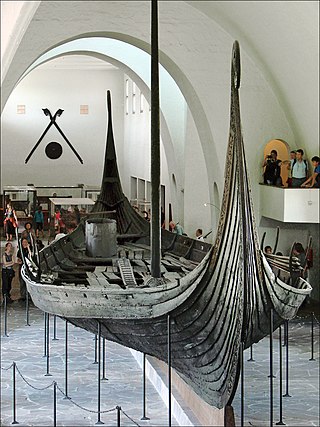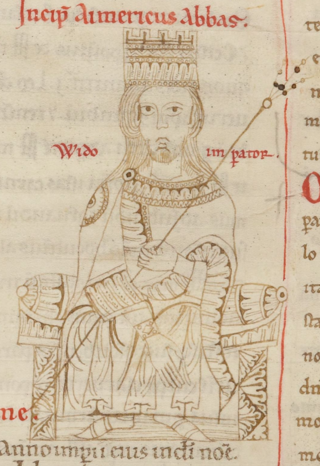
Year 834 (DCCCXXXIV) was a common year starting on Thursday of the Julian calendar.

Year 879 (DCCCLXXIX) was a common year starting on Thursday of the Julian calendar.

Desiderius, also known as Daufer or Dauferius, was king of the Lombards in northern Italy, ruling from 756 to 774. The Frankish king of renown, Charlemagne, married Desiderius's daughter and subsequently conquered his realm. Desiderius is remembered for this connection to Charlemagne and for being the last Lombard ruler to exercise regional kingship.

Louis II, sometimes called the Younger, was the king of Italy and emperor of the Carolingian Empire from 844, co-ruling with his father Lothair I until 855, after which he ruled alone.

The history of Italy in the Middle Ages can be roughly defined as the time between the collapse of the Western Roman Empire and the Italian Renaissance. Late Antiquity in Italy lingered on into the 7th century under the Ostrogothic Kingdom and the Byzantine Empire under the Justinian dynasty, the Byzantine Papacy until the mid 8th century. The "Middle Ages" proper begin as the Byzantine Empire was weakening under the pressure of the Muslim conquests, and most of the Exarchate of Ravenna finally fell under Lombard rule in 751. From this period, former states that were part of the Exarchate and were not conquered by the Lombard Kingdom, such as the Duchy of Naples, became de facto independent states, having less and less interference from the Eastern Roman Empire.

The Duchy of Benevento was the southernmost Lombard duchy in the Italian Peninsula that was centred on Benevento, a city in Southern Italy. Lombard dukes ruled Benevento from 571 to 1077, when it was conquered by the Normans for four years before it was given to the Pope. Being cut off from the rest of the Lombard possessions by the papal Duchy of Rome, Benevento was practically independent from the start. Only during the reigns of Grimoald and the kings from Liutprand on was the duchy closely tied to the Kingdom of the Lombards. After the fall of the kingdom in 774, the duchy became the sole Lombard territory which continued to exist as a rump state, maintaining its de facto independence for nearly 300 years, although it was divided after 849. Benevento dwindled in size in the early 11th century, and was completely captured by the Norman Robert Guiscard in 1053.

Guy III of Spoleto was the margrave of Camerino from 880 and then duke of Spoleto and Camerino from 883. He was crowned king of Italy in 889 and emperor in 891. He died in 894 while fighting for control of the Italian Peninsula.
The Duke of Spoleto was the ruler of Spoleto and most of central Italy outside the Papal States during the Early and High Middle Ages. The first dukes were appointed by the Lombard king, but they were independent in practice. The Carolingian conquerors of the Lombards continued to appoint dukes, as did their successors the Holy Roman Emperors. In the 12th century, the dukes of Spoleto were the most important imperial vassals in Italy.

Grimoald III was the Lombard Prince of Benevento from 788 until his own death. He was the second son of Arechis II and Adelperga. In 787, he and his elder brother Romoald were sent as hostages to Charlemagne who had descended the Italian peninsula as far as Salerno to receive the submission of Benevento. In return for peace, Arechis recognised Charlemagne's suzerainty and handed Grimoald over as a hostage.

Adelchis was the son of Radelchis I, Prince of Benevento, and successor of his brother Radelgar in 854.
Lambert I was the duke and margrave of Spoleto on two occasions, first from 859 to 871 and then from 876 to his death.
Ageltrude or Agiltrude was the Empress and Queen of Italy as the wife of Guy. She was the regent for her son Lambert and actively encouraged him in opposing the Carolingians, and in influencing papal elections in their favour.
The Supponids were a Frankish noble family of prominence in the Carolingian regnum Italicum in the ninth century. They were descended from Suppo I, who appeared for the first time in 817 as a strong ally of the Emperor Louis the Pious. He and his descendants were on and off dukes of Spoleto, commonly in opposition to the Guideschi clan, another Frankish family powerful in central Italy.
Suppo I was a Frankish nobleman who held lands in the Regnum Italicum in the early ninth century.
Adelard, Adalhard, or Adalard was briefly the Duke of Spoleto from March to August 824. Before Spoleto, he was the count of the palace. He was appointed to succeed Suppo I, but he died five months later and was replaced by Suppo's son Mauring.
Bertila of Spoleto was the wife of Berengar I of Italy, and by marriage Queen consort of Italy and Holy Roman Empress.
Suppo II was the Duke of Spoleto from 871 until his death. He was the archiminister (archminister) and consiliarius (counsellor) of the Emperor Louis II. In 869-870 he travelled to Constantinople as imperial missus together with Anastasius the Librarian, to negotiate a peace with the Byzantines. Throughout Louis's reign he was the most powerful lay magnate in Italy.
Adelchis I or Adelgis I was the Count of Parma by the 830s, of Cremona after 841, and eventually of Brescia. According to some sources, he succeeded to the Duchy of Spoleto in 824. He was a second son of Suppo I and father of Suppo II. His main area of interest was in the Aemilia and eastern Lombardy.
The Emirate of Bari was a short-lived Islamic state in Apulia, in what is now Italy, ruled by non-Arabs, probably Berbers and Black Africans. Controlled from the South Italian city of Bari, it was established about 847 when the region was taken from the Byzantine Empire, but fell in 871 to the army of Emperor Louis II.

The Frankish emperor Louis II campaigned against the Emirate of Bari continuously from 866 until 871. Louis was allied with the Lombard principalities of southern Italy from the start, but an attempt at joint action with the Byzantine Empire failed in 869. In the final siege of the city of Bari in 871, Louis was assisted by a Slavic fleet from across the Adriatic.